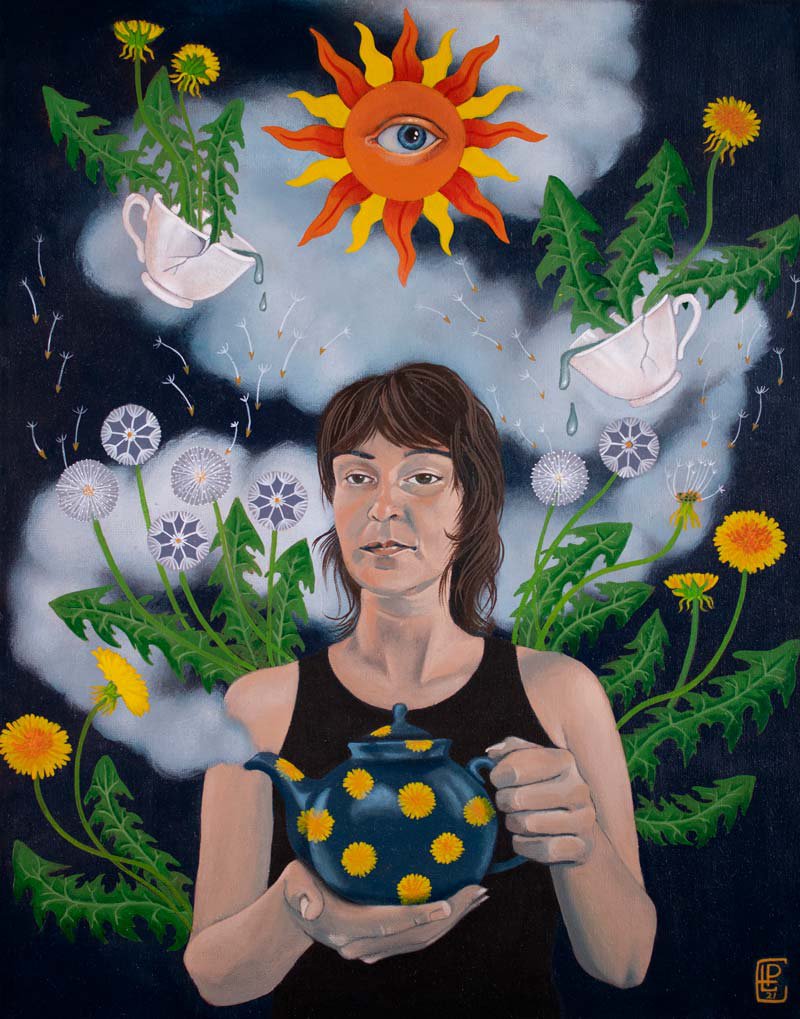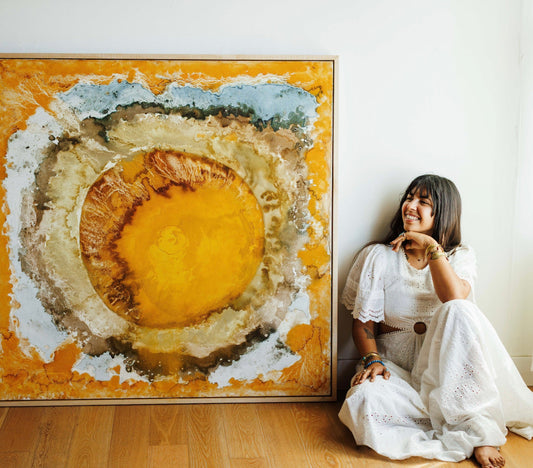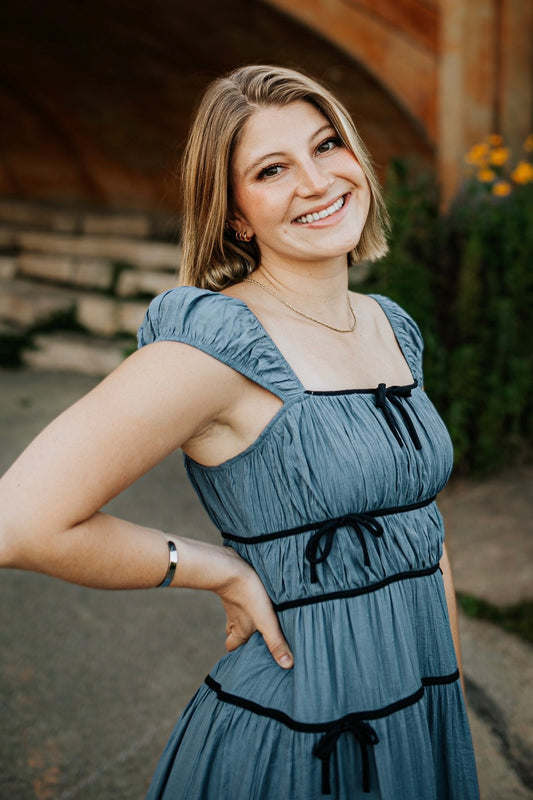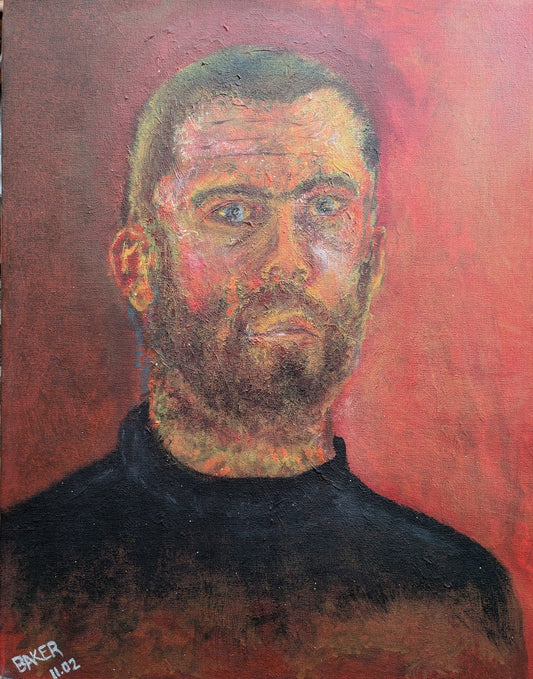Eerie Familiarity
Earth’s natural landscape is grounded in history. This history is passed down through generations not just by the telling of folklore and mythology, but by the plants themselves. Within these plants are tales of beauty and healing. Erica Peebus, a visual artist currently based in Portland, Oregon, harnesses these stories from folklore and the history behind medicinal plants to illuminate the duality of nature’s cycles and our natural world’s connection to the spiritual realm. She shares her work with over 3,000 followers on Instagram while providing a behind-the-scenes look at her paintings and what inspires their creation.


A Seeker
Erica described her childhood as growing up in a more rural setting outside of St. Louis, Missouri. However, throughout her childhood, she yearned for an urban environment. Since moving to Portland, she has grown to appreciate the bucolic environment she was raised in. Now that she is in the city, she reminisces on the duality of nature and how its complexities can be expressed in visual art.
Erica's drive to seek a deeper understanding of life led her to hypnotism school, where she talked about her experiences with lucid dreaming and spirituality. She elaborated that her upbringing helped facilitate her curiosity about the natural world. “Ever since I was a kid, I was a seeker. Growing up, I always knew my family was not that religious at all, yet I made them drop me off at church every week. I was always sort of assuming that there's something more here,” Erica said. She reflects that her work is a nod towards her inquisitive side and her journey of embracing it.
Erica recollects a childhood memory of when she felt a spiritual connection to nature when watering her family garden with her mother at around five years old. The water hose created her rainbow as her mother watered their forget-me-nots. She describes the moment as if “the world is alive and everything is so amazing and beautiful and wonderful” and that she felt a sense of “godliness that's in the world around us that we kind of take for granted or we don't look at very often.” This expression of spiritual connection through mystical realism is just what makes an Erica Peebus painting stand out.


Reverence of the Natural Landscape
Exploration is a medium for inspiration, and it’s boundless for Erica. She recalls, “I was starting to hike regularly, and I was out in the woods all the time. And I wanted to learn more about herbalism because I just kept seeing all these plants and learning more about them, and I was like, ‘Oh my gosh, this is very cool.’” This curiosity for herbalism, the practice of healing using medicinal plants inspired her nine-piece collection “Herbalism”, focusing on one herb in each piece. The collection approaches the understanding and utilization of these plants with a mindset of reverence and respect for the natural world, capturing the power of the spirit of these organisms that are otherwise underestimated or overlooked to the untrained eye.
The elaborate research that goes into the plants then turns into inspiration, playing a crucial role in the development of characters within her art. “As I was researching each plant, I was also sort of going and being with that plant experiencing that plant for myself and trying to get that sort of behind the scenes that little one dimension over…what is the spirit of this plant, and then painting from that sort of perspective.” Erica said, “I really loved that whole project. And while I don't want to paint just strictly herbs for the rest of my life, I like that sort of way of exploring.”
This reverence is explored and expressed through many of her works. The Gatekeepers depicts a skeleton surrounded by two kinds of flowering plants. On the surface, the skeleton could be interpreted as the ‘gatekeeper’ because it is placed in the center of the painting, however, the plants are actually those that are the focal point of the work, encapsulating the power of investigating a scene beneath the surface.
Art Blocks and Comparison-itis
In 2020, Erica worked on a 100-piece collection of watercolor paintings. While working with the medium, she maintained a free-flowing creativity by touching a paintbrush to a square every once in a while until the layers formed figures. Erica said,
“The stack of papers were ongoing paintings that I made for months and months and months. Eventually, an object or a being, a lot of times it was animals, would sort of appear. And then I would really go and push that image forward.”
While the watercolor pieces still tie to her niche in nature and spirituality, the color palette was drastically different from most of her other works. Sometimes, these color resets can help cleanse one’s mindset on their work and their place in their career. “I feel a lot of times as an artist, you find yourself really inspired, and then you find times where… imposter syndrome sets in the feelings of, what am I even doing?” Peebus said. She wasn’t creating the work she wanted to. She was creating art during a time when she was questioning her stance and place as an artist. The series expanded her awareness of color choice and subject to build a cohesive work and consistent style.


The Creative Process and Color Cohesivity
Erica maintains her connection to nature by hiking every Monday and Friday, where she is on the lookout for new plants to research and portray in her artwork. She explores the dense, hilly wooded forests filled with ferns and fungi to remain grounded in her connection to the landscape and to her craft. Working this habit into her daily life has noticeably shifted the trajectory of her work from a depiction of a destination to an illustration of a journey. “My art in a way has been a tool to learn about my environment, which has been really fun and I'm sure I'll take that with me to Indiana because it's a whole new environment to me,” Erica said.
While maintaining physical contact with nature keeps a fascination for beautiful plant and animal life, it also helps embrace and understand its darker, more cryptic sides. She depicts both sides in a setting in which they are dually embraced and celebrated. To Erica, these mystical and cryptic facets are “every bit a part of nature as the cute frilly stuff…when you put it together, there's something really special that happens.” Through Erica’s paintings, skeletons and blood are just as connected to the spiritual realm and deserving of reverence as rainbows and butterflies.
Her color palette helps maintain the balance of these two aspects of nature. Peebus described the process of refining her color palette as difficult but necessary because she wanted to make her works stand out as her own. “I wanted to get it to five colors, but I got 10. But I worked with these same colors over and over and over again,” Peebus said. Even still, she prefers to mix a touch of black and white into all the pigments she works with to make them more cohesive in her works. By doing so, the vibrance of plants and animals is emphasized while leaving an equal playing field for the darker, more untamed sides of nature to show. Even her color palette was designed with a drive for reverence for both sides of nature to show their true colors, their own story.


Finding Acceptance in Community
Erica moved to Portland in her twenties when she was up and coming as an artist. Upon arrival, she found that the area was rich with passionate artists. “Portland's just so full of artists. You throw a stick and you hit one.” Erica said. This made showcasing art and collaborating with artists in curation more tight-knit and local by reaching out to others and displaying works that align with a theme. She has since come to view her work as a testament to being truer to herself, giving herself the same reverence she gives the plants in her work, embracing the spiritual sides of herself just as much as nature. After almost twenty years of time in Portland, she is moving to Fort Worth, Indiana. It will be exciting to watch how her work transforms with this fresh start as well.
©ArtRKL™️ LLC 2021-2023. All rights reserved. This material may not be published, broadcast, rewritten or redistributed. ArtRKL™️ and its underscore design indicate trademarks of ArtRKL™️ LLC and its subsidiaries.





